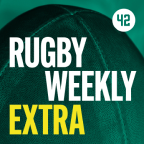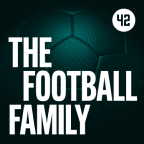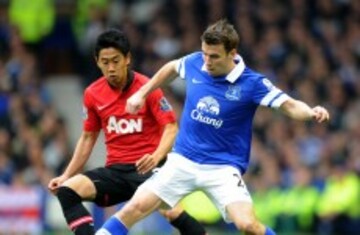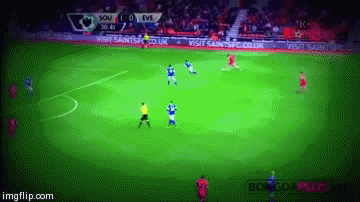IRELAND INTERNATIONAL SEAMUS Coleman was always regarded as a player with enormous potential ever since making his Everton home debut as a substitute against Tottenham in 2009-10 season.
However, it wasn’t until last year, under the guidance of new manager Roberto Martinez, that he truly flourished and established himself as one of the top full-backs not just in the Premier League but in Europe, attracting interest from sides as reputed as Manchester United and Arsenal as a result, before eventually agreeing a new deal with Everton during the summer.
One of the reasons why Coleman has impressed so much of late is that Everton’s system under Roberto Martinez patently plays to his strengths. Of course, he was still regarded as an attacking full-back under David Moyes, but the Ireland international was given far more defensive responsibilities and was consequently rendered much less effective down the other end of the field when played at full-back (though he was sometimes deployed on the right wing by the Scottish manager).
So unsurpringly, the player’s recent stats reflect Coleman’s increasingly unrestricted attacking prowess. He did manage four goals in 34 appearances for Everton in the 2010-11 season, though this was the year that he was often deployed on the right wing.
He failed to score any goals in the Premier League in the two seasons thereafter, making 18 and 26 appearances in the respective ensuing campaigns (he also managed just one goal in 55 appearances for Sligo Rovers). Yet he was given a new lease of life under Roberto Martinez, and duly scored six times in 36 appearances, a considerable achievement for someone who is primarily a defender.
Yet with Everton’s two central midfielders — usually James McCarthy and Gareth Barry — protecting the centre backs, both Coleman and Leighton Baines were given license by Martinez to get forward at will last year, with both at times effectively operating as wingers in the absence of traditional ones in the Everton side.
The one lingering criticism of Coleman, of course, is his defensive capabilities, which have been questioned by some, most notably Roy Keane (when serving as a pundit for ITV last year). He also made one high-profile gaffe in a recent Ireland friendly (more on that later), which along with a few other errors at the back, suggest he still can improve in this area of the game.
When TheScore.ie spoke to Everton coach Alan Stubbs last year, he admitted that defence was the skill that came least naturally to Coleman and emphasised that in recent years, it is the part of his game that he has worked on more than anything else. That said, last season was by no means a disaster in that regard, with the Donegal native’s continual application clearly paying dividends. Though Coleman was by no means the pillar of Everton’s back four, he invariably looked quietly assured in doing what was needed more often that not.
And the result? Everton finished the season with just 39 goals conceded — a feat bettered only by Man City (37) and Chelsea (27). Such an impressive stat simply isn’t achieved without all four members of the backline contributing significantly, and it was all the more impressive given that — Coleman aside — Everton’s defence was rarely completely settled, with Sylvain Distin, Antolin Alcaraz, Phil Jagielka, John Stones, Leighton Baines and Bryan Oviedo all featuring at various points.
So inevitably, much is expected of Coleman this year, as he bids to consolidate his already considerable reputation and potentially earn a regular berth in the Champions League with or without Everton.
In this article, for the sake of simplicity, we’re focusing largely on one specific performance by Coleman — his man-of-the-match display in Everton’s 2-0 defeat of Manchester United — to show how he’s become so highly regarded in such a short space of time and why he has been such a vital part of the Toffees’ recent progress.
Calmness in possession
People in football sometimes tend to downplay the importance of a full-back (I’m looking at you, Jamie Carragher!), but teams will always struggle without strength in this area. Generally speaking, full-backs see more of the ball than any other player on the field, which is why it’s vital the individual deployed there has a cool head and is not prone to giving away the ball cheaply.
http://vine.co/v/MiPqXuIlZUi
Seamus Coleman, luckily for the Toffees, excels in retaining possession and almost always maintains his composure on the ball. Perhaps the most memorable example of his confidence and skill under pressure was not against United but Arsenal, when he showed off some GAA-esque skills (see above), as well as bamboozling Santi Cazorla at one point (see below).
http://vine.co/v/MiPMtqPKA7E
Coleman’s quality was also starkly evident in the United match. In the opening minute, he received the ball from a teammate and was subsequently chased down by an onrushing Wayne Rooney. Lesser players would have belted the ball out of play in desperation, yet Coleman had the coolness, intelligence and ability to carry the ball past a slightly overzealous Rooney, before taking the time to realise that there was not much on ahead of him and passing it back to Stones.
So simply put, as with Roy Keane in his prime and all other top players — his decision-making with the ball at his feet is flawless far more often than not.
Attacking threat
It was mentioned earlier that Coleman invariably serves as a utility winger, as well as a defender, and the aforementioned Manchester United clash was no exception. Indeed, he was Everton’s primary attacking outlet for much of the game, with their forward play usually emanating down the right flank.
In an attempt to combat the 25-year-old’s threat, United had inexperienced full-back Alexander Büttner paired with Shinji Kagawa, who constantly tended to drift into the centre, and Moyes’ team were consequently a little vulnerable down that side of the field. And unsurprisingly, Coleman, with his persistent marauding runs forward, took full advantage of this weakness.
The full-back was often the Everton player who was highest up the pitch and could frequently afford to be, owing to the lack of threat posed by United down the left flank (see images above and below).
Although United belatedly noticed the problem and gradually acquired more discipline in this area of the field, the former League of Ireland star had already done serious damage to them by that stage. Their failure to close down space and tendency to stand off him (see below) allowed Coleman to put several dangerous crosses in and make threatening runs at will.
Pace and talent
The encounter last April between United and Everton at Goodison Park, which turned out to be David Moyes’ last game in charge of the former, was proof that possession is not necessarily nine-tenths of the law in football. The visitors dominated in this regard, having over 60% of the ball in the first 15 minutes alone, yet they couldn’t muster a clear-cut chance until the dying stages of the 90, and had just two shots on target in total over the course of the game.
Everton, by contrast, saw less of the ball, but used what little possession they had to maximum effect, with Coleman the architect of much of this good work.
The Donegal native is one of the fastest players in the Premier League both with and without the ball, and he exposed his more slovenly opponents time and again on the counter-attack.
While United played plenty of pretty, intricate football on the day, it was no match for the decidedly more direct approach of Coleman and company. The Old Trafford outfit could not handle the 25-year-old, as he repeatedly demonstrated his formidable pace and power, as well as showing no shortage of skill.
The latter attribute was patently evident amid Everton’s all-important second goal. Coleman had given United several warning signals, consistently getting forward and floating a number of dangerous crosses into the box that were eventually cleared, usually unconvincingly. Nonetheless, the Ireland star punished the Red Devils severely on 43 minutes, as his perfectly judged through pass was finished consummately by Kevin Mirallas, leaving the visitors with a mountain to climb in the second half.
Stamina and attitude
Though it may not seem to be asking much for a professional footballer to be extremely fit, Coleman still manages to stand out in this regard.
The full-back was officially Everton’s hardest-working player last season, covering more distance than any of his teammates, in addition to having the fastest average top speed.
These stats were reflected in the United game, in which Coleman demonstrated an incredible level of fitness and ability to regularly get up and down the flanks in a manner that was genuinely reminiscent of great full-backs of the past such as Cafu and Lillian Thuram — consummate athletes who would be just as at home in long-distance running as they were in football.
Of all Coleman’s many, near-relentless raids down the right flank against United, one stands out. In the 90th minute, with the game all but over at 2-0, he still had the hunger and desire to rampage forward, before hammering in a dangerous cross that Lukaku couldn’t quite manage to steer on target.
It was a moment that few people will have remembered from the game, given that its consequences were relatively insignificant, yet it epitomised Coleman’s best qualities. Many players, especially those whose primary responsibility is to defend, wouldn’t have bothered putting in the effort with the match finished as a contest, perhaps with an eye towards conserving energy for future games. Yet Coleman’s intense passion, immense work-rate and sheer love for the game prevented him from taking his foot off the pedal at any stage of the match regardless of the scoreline.
Flaws?
As mentioned already, Coleman has improved immeasurably as a defender since the early days when David Moyes was reluctant to deploy him as an out-and-out full-back.
He was barely tested in this regard against United, given how inept the Red Devils’ attack play tended to be. Yet if he is to be regarded as one of the best full-backs in Europe, which many people feel he is at the very least on his way to becoming, then he must be judged by the highest of standards.
Therefore, Coleman still has room for improvement defensively and appears prone to the odd individual error even now. He was, for instance, partially at fault for both the goals conceded in Ireland’s clash against Serbia back in March (albeit, it was only a friendly), inexplicably stepping up to play offside for the first one when it was never on and giving possession away cheaply in the build-up to the second (see below)
And as groundbreaking as his season with Everton was last year, it was also not completely without its flaws.
The below clip shows his own goal during the Toffees’ 2-0 defeat to Southampton last April. It was unfortunate but avoidable. Perhaps it is a case of Coleman being overly confident in his ability. Instead of flicking it further away from goal, he ostensibly, ill-advisedly tries to head it intricately either away for a corner or perhaps into goalkeeper Tim Howard’s arms, with evidently disastrous consequences.
So these rare lapses in concentration are something that Coleman could do with working on, but in truth, they are just minor quibbles. Critics could surely pick out isolated incidents of inept play from almost any Premier League star last year if they tried hard enough, and most footballers’ lowlights package would be far more extensive than Coleman’s.
Overall
Ultimately, last season, Seamus Coleman rapidly matured to unequivocally become a top-level Premier League full-back.
His consistent brilliance was acknowledged eventually, as the Ireland international featured in most commentators’ Premier League Team of the Season selections, most notably the official PFA one, as well as being included in the XI picked by Sky Sports pundit Gary Neville, who knows more than most about good full-back play.
This season, the pressure will be on Coleman (and indeed Everton in general) to sustain and build upon last year’s achievements, though given his admirable talent, experience and attitude, the odds are overwhelmingly in the Irish star’s favour to retain the high standards he has previously set.
Gifs via 101 Great Goals and IMG Flip



















Let’s be honest, the head area of a player must be protected, we know this, we saw in the world cup what needs to be punished and so on. But if that tackle is a 4 week ban, then it’s making a farce of things. He tried to wrap, and bounced off his shoulder. He tried to hit lower, but bounced off the contact as he tried to wrap and honestly I can’t even see where he made contact with the head in the replays I saw. TMO looked and went on during the match itself. There’s needs to be some sense here and this makes a joke of things
@Andrew Taz Donohoe: correct Andrew. That’s the way I see it too. He dips, he attempts a wrap and I see a head predominantly on front upper shoulder. No intent and not reckless either. Heads clashing unfortunately are part and parcel of a contact sport.
Huge blow, 4 really important games he’s missing. Length of the ban seems a bit harsh, but that’s the way the sport is going I suppose.
@Peter McCarthy: Deliberate elbow to face 6 weeks. Legal tackle with poor head placement 4 weeks. Doesn’t seem right to me.
@SilexFlint: legal mauling with poor elbow placement?
@Jim Demps: The guy who eye gouged tom curry got 6 weeks too. Deliberate malicious acts that can do serious damage to only the recipient, versus another where the damage is accidental and can be reciprocal. Since Addison is made of glass i’m surprised he didn’t need to be carted off too!
Would probably help to have a clip of the Addison tackle for context. Link here: https://streamable.com/fpph8
Looking at World Rugby’s high-tackle framework that the decision seems to be based on, the rationale seems to be as follows: High Tackle (high contact by tackler’s…) > Shoulder or Head (degree of danger) > High > Red Card.
If it forces player’s to tackle with the correct shoulder and reduces head injuries then fair enough. However, you would like to see referees and citing commissioners being more consistent in applying the laws to make a meaningful change to how players tackle.
@EK: That link is very helpful. Onus is on the tackler and it seems that Addison got his positioning wrong and failed to complete the tackle safely. I would classify it as reckless and 4 weeks sounds about right.
@Paul Ennis: what? To me Addison came off worse… he hit his own head off the guys arm/shoulder.
Nahh this makes a mockery of the law.
Ban is fair enough to be honest, he was always going to be found guilty, might have saved himself a week if he accepted the charge. Once the citing commissioners and refs are consistent with it from here on in then there can’t be many complaints.
@Jim Demps:
Yes I agree, the rules are there for a reason and the players will have to adapt.
For me the tackle was poor technique and at great risk to Addison to suffer injury, given where he placed his own head.
Players will have to learn the hard way to lower the tackle
@Jim Demps: very harsh ban….U wouldn’t be saying the same if twas Mike Haley
@john williams: wait and see I suppose, I’d more than likely be saying exactly the same thing though.
@john williams: It is a black and white reckless tackle I’m afraid. It shouldn’t matter which province you support to see that.
I realise that there is loads of provincial bias in these comment sections, but I am pretty sure that Jim agreed with Bundee Aki’s ban during the world cup. That would not support your theory.
@Mark Smith: Don’t think the height has anything to do with it, that was fine, it was head placement that was the issue. The head injury report did mention that more concussions occur in the tackler rather than person tackled, so for me the ban is fair enough, to reduce head injuries the tackler has to not endanger themselves. However the application will raise questions, should a tackle that has poor head positioning only be punished when there is head to head contact? Or should all tackles with poor head placement be punished as it had the potentional to cause head injuries?
@Kingshu: well of course the former. As the commission said. It was a reckless tackle that made contact with the head. The tackle is only reckless when contact is made. You don’t send off players for punching air. Now if they punch a face it’s different
@PScald: so you sentence based on outcome rather than intent? That’s what’s wrong at present. Throwing a punch is throwing a punch whether it connects or not surely
@RabidHorizon: so you think every tackle attempt with poor head positioning should result in a yellow card or worse? mate, I don’t think you should be watching rugby.
Ridiculous ban,there was nothing reckless about the tackle…he went for a wrap and both heads clashed…it happens in rugby…soon ankle tapping will only be allowed!
Some of the bias on here defies belief. Head first into the players opposite players chin/cheek. Reckless, read up a little on the effects of concussion in later life folks, Rugby has to sort this, or else its gonna end up ruining the game. Tackle low will also have the positive impact on the offloading game although the next problem with the tackler concussion through contact with knees!
Looking at the tackle several times in slomo..I honestly don’t see any reckless play at all..just an attempted wrap and a clash of heads.
Very harsh decision…ridiculous
@Ronan Skelly: It is extraordinary how 2 people can look at the same clip and come to opposite points of view.
Will addison is responsible for his poor technique and head placement. This is a blight on our professional sport that I rarely see in amateur / youths rugby. Leading players like Will (and others such as Sexton, Farrell, Biggar) regularly set a bad example to kids and, incorrectly, portray a negative image to parents selecting a sport for their 6 year olds.
Bams like this are the only way to ensure long term improvement.
@Ronan Skelly: the rule has changed. Players must tackle lower or suffer the consequences. Harsh lesson for Addison but not as bad as the long term effects of repeated concussion.
Agreed no harm intended.
This was a 100% rugby incident , no malice from Addison , he wrapped his arms and his shoulder hit the opponent below shoulder level . If Addison had gone off with a head injury nothing else would have happened.
Harsh !
Positioning was a bit high but cpntact with his shoulder, length of ban is not proportionate
Hope the referee and the TMO also get punished. This was a red card offence.